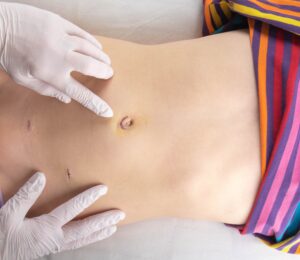Those with endometriosis oftentimes will experience pain and discomfort with intercourse, especially pain with deep thrusting, also known as deep dyspareunia. However, many people also experience a different type of pain that extends beyond intercourse – superficial dyspareunia or pain upon entrance. Many people will have been diagnosed with ‘vaginismus’ and oftentimes given dilators, told to “just relax” or “have a glass of wine,” which is terrible advice. While some may have vaginismus, or pelvic floor dysfunction, for many the culprit could be that birth control pill that was given to you and advertised as a treatment for your endometriosis. It is a mixed bag on how many people benefit from the use of oral contraceptive pills (OCPs), and they can be a helpful tool for many. That being said, one thing is certain: medications always have consequences – sometimes good, sometimes not good.
In today’s blog, we will discuss a condition called vestibulodynia, and we will specifically cover hormonally associated vestibulodynia which is a prevalent health concern that results in pain in the vestibule, the tissue within the vulva at the opening of the vagina which also surrounds the urethra. It’s a subcategory of a broader term, vulvodynia, which refers to chronic pain in the vulva. This article aims to provide an in-depth understanding of vestibulodynia, its causes, symptoms, and effective treatment methods.
Vestibulodynia vs Vulvodynia vs Vaginismus?
Vestibulodynia is a general term used to describe discomfort in the vestibule, a part of the vulva that sits at the entrance of the vagina. The vestibule is the transition point between external and internal, similar to the entrance of a building. Vulvodynia is the broader category that includes vestibulodynia but can be pain anywhere in the vulva and typically is present for longer than three months and has specific causes and associated factors. Vaginismus lies within these and often is a misdiagnosis, the term refers to a chronic muscle spasm upon penetration or attempted penetration. This is one of the oldest terms used and while some may have true vaginismus, in the case of endometriosis there are much more likely causes, such as the birth control pill and other hormonal suppressive agents.
Think about it – if you touch a hot stove, the muscles in your shoulder and arm reflexively pull you away. If a penis, speculum, finger, or tampon hit tissue that is painful and irritated, the surrounding muscles will tense reflexively because it is painful. So yes, there is a muscle spasm, but the cause of the spasm is the inflamed and painful vestibule, possibly due to consequences from the birth control pill. There are other causes of pain here, which we will cover in future blogs.
Subtypes of Vestibulodynia
Recent research has led to the identification of a few subtypes of vestibulodynia based on the root cause of the discomfort:
· Neuroproliferative vestibulodynia
· Hormonally-mediated vestibulodynia
· Inflammatory vestibulodynia
The vestibule tissue is fundamentally different from the skin around it, developing from a different part of the embryo. This biological difference is crucial to understanding the causes of pain specifically in the vestibule. In this post, we will be reviewing hormonally mediated vestibulodynia, and in upcoming posts we will discuss neuroproliferative vestibulodynia as there are some interesting new research in the connection between neuroproliferative vestibulodynia and endometriosis.
Causes of Vestibulodynia
The reason why some individuals develop vestibulodynia while others do not, is still under investigation. However, a 2014 study suggests that there may be a genetic risk factor for developing vestibulodynia when taking anti-androgen medication.
Hormonally-mediated vestibulodynia can be caused by several factors, times in life or medications that alter hormones and result in a suboptimal state. This could be during periods of amenorrhea (lack of a period) in young adults, medications including combined oral contraceptive pills, aromatase inhibitors used in breast cancer, and other hormonal suppressive medications as well as acne medications (Accutane and Spironolactone). Periods in life that result in reduced hormones including breastfeeding (lactational amenorrhea) and perimenopause through menopause which we describe as GSM (genitourinary syndrome of menopause). The vestibule tissue is particularly sensitive to a lack of hormone signals, so for those with endometriosis, while your birth control may be helping your painful periods, it maybe causing you to have painful intercourse.
Symptoms of Vestibulodynia
Pain.
Individuals with vestibulodynia typically experience discomfort at the entrance of the vagina, known as the vestibule. The pain in the vestibule can be described in many ways. People with hormonally-mediated vestibulodynia may describe their discomfort as burning, stinging, or tearing.
Provoked vestibulodynia refers to vestibular pain that occurs with touch or pressure, while unprovoked pain occurs spontaneously. Sometimes, it can be challenging to distinguish provoked from unprovoked pain before all triggers are recognized, especially when they are seemingly simple things like sitting or wearing tight clothing.
People often feel discomfort any time there is contact or pressure on the vestibule. This includes during vaginal penetration (dyspareunia), tampon use, and speculum exams. Day-to-day activities that put pressure on the vestibule, such as wearing tight clothing, sitting for long periods, or wiping with toilet paper, can also cause discomfort.
Urinary.
Because this tissue also impacts the urethra, for some, the primary symptoms are urinary in nature. Urinary urgency, frequency, or UTI-like feelings without an infection are common and some will even receive a diagnosis of interstitial cystitis/painful bladder syndrome, also very common to see in those with endometriosis.
Pelvic Floor Tightness
It is believed that pelvic floor dysfunction may develop in people with vestibulodynia due to a subconscious guarding response against discomfort (remember the stove analogy). However, chronic tightening of the pelvic floor muscles can create more discomfort. The muscles can accumulate knots (trigger points) and become shortened and weak. The weakness is because the muscles are not functioning optimally, please do not go and do kegels!
Additional symptoms of pelvic floor dysfunction can include feeling tension, discomfort, and burning in the hips, legs, lower back, and vulva, especially the vestibule. One can also experience urinary symptoms like frequency, urgency, and leakage, as well as bowel symptoms like constipation or discomfort with bowel movements.
Diagnosis of Vestibulodynia
The first step towards diagnosing vestibulodynia is a thorough history of your story by a knowledgeable provider. Your story holds crucial clues to your diagnosis. People with hormonally-mediated vestibulodynia may have discomfort that developed later in life after any of the associated factors discussed above, including starting a medication, surgery, breastfeeding, or menopause.
Then there should be a very specific examination of the pelvis, vulva, and vagina. In patients with hormonally-mediated vestibulodynia, the vestibule usually appears very red and irritated (erythema), but also pale (mucosal pallor). The provider should manually examine the pelvic floor muscles to determine if there is excess tension in the muscles.
A process called a Q-tip test is essential for mapping discomfort in the vulva. The provider will gently press a cotton swab to each part of the vulva while the patient reports their degree of discomfort at each spot. It is important that the provider touch each region of the vestibule, all the way around the vaginal opening. The physical exam is extremely important prior to using dilators as this may cause more irritation because the cause (or one cause) of the muscle tension is the vestibule and needs attention before dilators come into treatment.
Some specialists will check labs including total testosterone, free testosterone, and SHBG (sex hormone binding globulin), and many with hormonally mediated vestibulodynia show altered levels; though you do not need labs to confirm this diagnosis.
Treatment of Vestibulodynia
Fortunately, in the case of hormonally-mediated vestibulodynia, the standard treatment has a very high success rate. If vestibulodynia developed after starting a medication that is known to affect hormone levels, then patients should stop taking that medication. Stopping the medication is often not enough to help the vestibule tissue heal quickly because hormone levels might stay low for a long time after taking birth control pills.
Providers should prescribe a topical hormone gel to apply directly to the vestibule to restore the hormone signals to the tissue. The standard is 0.01-0.03% estrogen and 0.1% testosterone gel. The hormone gel is usually made by a compounding pharmacy. Custom compounded medications are especially helpful if someone is sensitive to a medication’s base, the inactive ingredients, and needs a different base.
Patients typically use the gel 1 to 2 times daily and start to notice improvement in 6 to 12 weeks. Some patients stop using the hormone gel once the offending medication has been stopped for a while, but many women choose to stay on this therapy.
Support for Vestibulodynia Patients
There are many societies with interests in female sexual dysfunctions in addition to ISSWSH. The National Vulvodynia Association (NVA) is a US-based association founded by patient advocates that focuses specifically on vulvodynia. They provide some educational materials for the public and fund research of vulvodynia. Tight Lipped is also a patient facing, grass-roots, advocacy group helping to change medical education around this condition.
There are many online support groups and communities of patients who support each other on social media. To find fellow patients locally, ask a provider if they know of another patient seeking community or any local groups to join.
Conclusion
Understanding and effectively managing vestibulodynia necessitates a comprehensive understanding of its causes, symptoms, and treatments. The information in this article seeks to bridge the gap between scientific research and the general public, providing evidence-based insights into this prevalent health concern. If you are experiencing symptoms of vestibulodynia, seek advice from a healthcare professional. There is a broad range of treatment options available, and you are not alone in your journey towards healing and managing this condition.
While this article provides a comprehensive overview of vestibulodynia, it is essential to remember that each individual’s experience with the condition can vary. Therefore, it’s crucial to consult with healthcare professionals and consider personal circumstances when making decisions regarding management and treatment.
Find a specialist: www.isswsh.org
Additional reading:
- Managing Endometriosis: What You Need to Know
- Understanding the Relationship between Sex and Endometriosis
- Finding an Endometriosis Specialist: Your Guide to Effective Treatment
References:
- Rubin, R. W. C. (2022). Hormonally mediated vestibulodynia. Accessed from https://www.prosayla.com/articles/hormonally-mediated-vestibulodynia
- Burrows LJ, Goldstein AT. The treatment of vestibulodynia with topical estradiol and testosterone. Sex Med. 2013 Aug;1(1):30-3. doi: 10.1002/sm2.4. PMID: 25356284; PMCID: PMC4184715.




